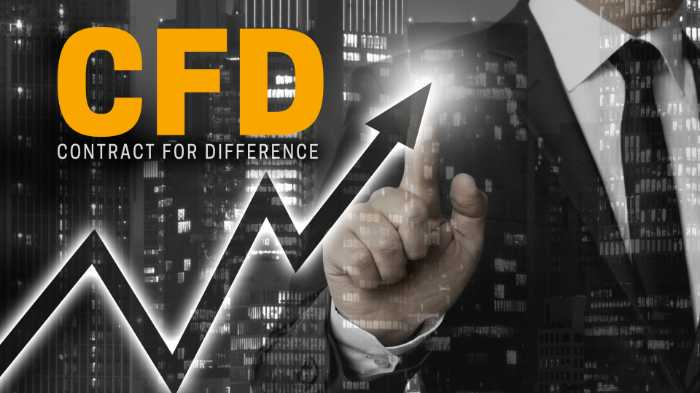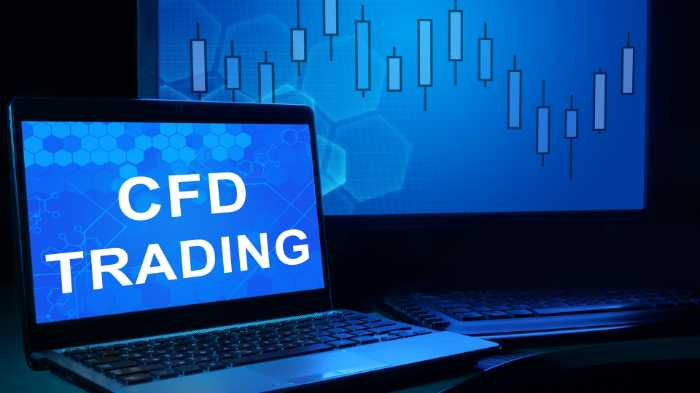
CFD stocks, or Contract For Difference stocks, are a unique type of investment. They allow you to trade the stock market without actually owning any shares of the company. This can be a great way to get into the stock market without taking on too much risk. In this blog post, we will discuss what CFD stocks are and how you can trade them!
- What are CFD stocks and what do they mean for investors?
- What are the benefits of CFD trading?
- What are the risks of trading CFDs?
- How does trading CFD impact retail investor accounts?
- FAQs
What are CFD stocks and what do they mean for investors?

A CFD, or Contract for Difference, is a contract between two parties. It stipulates the price of an underlying asset at a specified time. The differences in price are then settled in cash. CFDs are traded on margin, meaning that investors only need to put down a small deposit to open a position. This can provide considerable leverage, but it also carries a high degree of risk.
CFDs are not suitable for all investors. When trading CFDs, it is important to be aware of the potential for losses. There are also commissions and fees that may be charged by the broker. In some cases, these costs can eat into any potential profits and the investor accounts lose money. However, with careful research, you will gain a solid understanding of the risks involved. CFD trading can be a profitable way to invest in the financial markets. One quick study method of CFDs is social trade or copy trade. This is the act of learning while following or copying the market moves of an experienced trader. Several platforms offer this service which you can review here.
How can you trade CFD stocks?

CFD stocks are another type of financial instrument. They allow you to speculate on the price movements of stocks without actually owning the underlying shares. When you trade CFDs, you enter into a contract with your CFD broker. This gives you the right to buy or sell a certain number of shares at a set price. If the stock price moves in the direction you anticipated, you can make a profit. If it moves against you, you will incur a loss.
CFDs are traded on margin. This means that you only need to put down a small deposit to open a position. This makes CFDs an attractive option for investors who want to take advantage of Leverage To trade CFDs.
To get started, you will need to open an account with a brokerage that offers CFD trading. Once your account is approved, you can deposit funds and start placing trades. It is important to remember that CFDs are a leveraged product, which means that your losses can exceed your deposits. As such, it is essential to use proper risk management when trading stock CFDs.
Savvy investors copy top-performing traders. When they trade, you trade.
Choose a broker based in the region where you reside.
eToro USA LLC and eToro USA Securities Inc.; Investing involves risk, including loss of principal; Not a recommendation
Socially Responsible Investing Platform – CA
Copy Trading Platform – UK & EU
ESG & Sustainable Investing Platform – UK & EU
Copy Trading Platform – Global
ESG & Sustainable Investment Platform- Global
eToro is a multi-asset investment platform. The value of your investments may go up or down. Your capital is at risk.
What are the benefits of CFD trading?
1. Leverage
CFD contracts are typically margin traded. This means that investors can control a large position with only a small amount of capital. This leverage can lead to both profits and losses. For example: an investor buys a CFD contract with a 10% margin. Then the underlying asset increases in value by 10%, and the investor will double their money. However, if the asset decreases in value by 10%, the investor will lose their entire investment. Therefore, it is important to use leverage wisely and to always maintain a stop-loss order to protect your capital.
2. Lower Costs
When you trade CFDs, you never actually own the asset. Instead, you are simply speculating on the asset’s price movement. Because of this, transaction costs are typically much lower than if you had bought the asset outright. In addition, there are no stamp duty or commission fees payable on CFD trades in most jurisdictions. This makes CFD trading an attractive option for investors who are looking to trade with a limited budget.
3. Easier Access to Global Markets
CFD trading gives investors easy access to markets all around the world. For example: an investor in London can trade US shares without having to open a US brokerage account. This makes CFD trading an attractive option for investors who want to diversify their portfolios beyond their local markets.
4. Short Selling
Short selling is a trading strategy that involves selling an asset in the hope of making a profit when the price falls. CFD traders can benefit from short selling in two ways. First, it allows them to profit from falling prices. Second, it provides them with greater flexibility when designing their trading strategies. For example: a trader who is long on an asset may wish to short-sell a different asset as a hedge against potential losses. By being able to short-sell, CFD traders can make more informed decisions about how to deploy their capital.
5. Ease of execution
When you trade CFDs, you don’t need to worry about things like storage, security, or insurance. This is because you never actually own the underlying asset. Instead, you are simply speculating on the price movements. CFD trades can be placed online or over the phone with most brokers. This process is typically much simpler than buying or selling the underlying asset. For example: to buy shares in a company, you would need to open a brokerage account. Then you would need to transfer funds, and then place your order. With a CFD trade, you can be up and running in minutes. This ease of execution is one of the key benefits of CFD trading.
6. Availability
Another benefit of CFD trading is the availability of a wide range of markets. Contracts for difference can be traded on shares, forex, indices, commodities, and cryptocurrencies. This means that traders have the opportunity to invest in a variety of assets. But they will also be able to take advantage of price movements in different markets. This gives CFD traders a broad range of opportunities to profit from market fluctuations.
CFD trade can make you a lot of money, but on some occasions, investor accounts lose money as well. So, gain experience before jumping into the opportunity of stock CFDs and overall financial markets.

What are the risks of trading CFDs?
Trading CFD stocks comes with a number of risks that potential investors should be aware of before entering the market.
1. Leveraged trading can go wrong
Leverage is a double-edged sword. It can amplify your profits if the market moves in your favor. But it can also magnify your losses if the market moves against you. That’s why it’s important to understand how leverage works before you trade any CFD stocks.
When you trade on margin, you’re essentially borrowing money from your broker to finance your trade. For example, let’s say you want to buy $10,000 worth of ABC Corporation stock. However, you only have $5,000 in your account. With a 50:1 leverage ratio, you can still make the trade by putting up $5,000. Then you can borrow the other $5,000 from your broker.
If the price of ABC stock goes up by 10%, you would make a profit of $500 (10% of $5,000). However, if the price of that stock goes down by 10%, you would incur a loss of $500 (10% of $5,000). In other words, leverage can lead to both profits and losses.
Leverage can be a helpful tool if used correctly, but it can also be very dangerous. That’s why it’s important to understand how it works before you trade any CFD stocks.
2. Slippage
Slippage is one of the risks inherent in trading CFD stocks. When placing a trade, there’s always the potential that the order won’t be filled at the desired price. Slippage can occur when there’s a sudden change in market conditions or if there’s low liquidity in the stock. Investors may end up buying or selling at a price that’s different from what they expected. Again, this can lead to losses.
To avoid slippage, investors need to be aware of the potential risks and take steps to protect themselves. For example: limit orders will ensure that their trade is filled at the desired price. They can also watch for changes in market conditions and adjust their orders accordingly. By taking these precautions, investors can help minimize their risk of experiencing slippage.
3. High volatility
When trading stocks, one of the key considerations is volatility. Volatility is a measure of how much the price of a stock fluctuates. And it can have a significant impact on your trading strategy. Traditional stocks tend to be relatively stable, but CFD stocks can be much more volatile.
This volatility can make it more difficult to predict price movements. It can also lead to larger losses if you’re not careful. For this reason, it’s important to understand the risks associated with CFD stock trading before you begin. With careful planning and a solid understanding of the market, you can trade CFD stocks successfully despite the increased volatility.
4. Identity theft
When you trade CFDs online, you provide your personal and financial information to the broker. This information is then stored on the broker’s servers, which are usually located in another country. If these servers are hacked, or if the broker itself is fraudulent, your information could be compromised. This could lead to identity theft or fraud, both of which can have serious financial and legal consequences.
To mitigate the risk of losing money rapidly, make sure to only trade with reputable brokers who have strong security measures in place. And always be vigilant about safeguarding your personal information.
5. No negative balance protection
Most CFD brokers don’t provide negative balance protection, meaning that traders can lose more than their account balance. This is a big risk for traders. It really means that they can end up owing money to the broker if the trade goes against them. There are a few brokers who offer negative balance protection, but they are often the minority. This is something that all traders should be aware of before they start trading CFD stocks.
Without this protection in place, traders could quickly find themselves in a lot of debt. So manage your risks properly. As such, it is essential to trade carefully and always keep an eye on your account balance. If you do end up owing money to your broker, you may be able to negotiate a payment plan. More often than not, this will likely come with high interest rates. In short, negative balance protection is an important consideration for all CFD stock traders.
6. Low industry regulation
Most countries have some form of regulation around trading stocks, but not CFD stocks. Because CFDs are traded OTC (over-the-counter), they are not subject to the same level of scrutiny as traditional stocks. As a result, there is a greater risk that CFD providers may engage in fraud or manipulate prices. In addition, there is also a risk that CFDs may be delisted from exchanges without notice. This could leave investors stranded. For these reasons, it is important to be aware of the risks before trading CFD stocks. While the potential rewards may be high, the risks should not be ignored.
7. Fee & commissions
Investors should also be aware of the fees & commissions charged by brokers for CFD trades. These fees can eat into profits, so it is important to compare different brokers before deciding where to trade. Additionally, some brokers may also charge hidden fees. So it’s important to read the fine print before signing up for an account. However, by being diligent, investors can make sure that they are getting the best deal possible while trading CFDs.
By understanding these risks, investors can be better prepared for what to expect when trading CFDs.
Savvy Investors are also reading…
The Best Sites to Learn How the Markets Work
The Best Artificial Intelligence Investing Sites
The Best Supported Algorithm or Quant Trading Sites
How does trading CFD impact retail investor accounts?

When retail investors trade stocks, they are buying and selling shares of actual listed companies. Trading forex, on the other hand, involves buying and selling currency pairs. The goal is to make a profit from the difference in the exchange rate.
Stock CFD trading is becoming increasingly popular with retail investors. The attraction is that it offers the opportunity to trade on the price movements of popular companies. Minus having to go through the process of actually buying and selling shares.
However, CFDs are complex instruments and carry a high risk of losing money rapidly due to leverage. Retail investor accounts lose more money trading CFDs than any other type of instrument. If you’re thinking about opening a CFD trading account, it’s important to understand the risks. These are complex instruments and you need to be aware of the high risks involved.
Why do stock CFDs have a high risk of losing?

Because they are complex instruments, they carry a high risk of losing. Retail investor accounts lose more commonly since they don’t have a lot of experience with stock trading.
When you trade stock CFDs, you’re essentially betting on the price movement of a particular stock. If the stock price goes down, you lose money. Conversely, if the stock price goes up, you make money. Stock CFDs are traded on the stock exchange, and the prices are determined by supply and demand. You can buy or sell stock CFDs at any time during trading hours. Before trading stock CFDs, it’s important to do your research and understand the risks involved.
What is the Sell price and how important is it in stock CFD trading?
In stock CFD trading, the Sell price is the price at which a trader can sell a stock CFD. The Sell price is important because it determines how much profit or loss a trader will make on a trade.
Because of this, it is important for traders to understand how stock CFDs work before opening an account. CFDs are complex financial instruments and most retail investor accounts lose money when trading them. Before trading stock CFDs, investors should seek independent financial advice as any wrong decision can result in losing money rapidly. CFDs are not suitable for everyone and if done wrong, you may lose more than your initial investment.
In Conclusion
As with any investment, trading CFDs involves both advantages & risks. Before opening a CFD account, it’s important to understand the risks involved and how these complex instruments work. Because of the high risk of losing money when trading CFDs, it is important for investors to do their homework. Although stock CFDs offer the opportunity to make large profits, they are also complex and can be difficult to understand. CFDs are not suitable for everyone and if done wrong, you may lose more than your initial investment. The best way to learn CFD trading is to follow a trade or social trade with a successful trader.
FAQs

How to trade CFDs the right way?
It is essential to trade stock CFDs responsibly and to use stop-loss orders to limit your exposure to risk. With proper risk management, trading CFDs can be a successful and exciting way to participate in the markets.
What is capital gains tax?
It is a tax on the profit from the sale of an asset. It can be a stock, bond, or piece of property. The tax rate depends on how long you hold the asset and your income bracket.
What are the opening and closing prices?
The opening price is the starting price of a security when the market opens for trading. The closing price is the last traded price of a security when the market closes. The opening and closing prices are used to calculate the net change in a security’s price.
What are spread bets?
Spread betting is a type of wagering. It allows bettors to win or lose based on the price movement of a commodity. The amount won or lost is determined by the difference between the bettor’s entry price and exit price. Then multiplied by the size of the bet. Spread betting is popular in financial markets such as forex, stocks, and commodities.
What is margin trading?
Margin trading is a type of trading where you trade with borrowed money, using your investment as collateral. This can help you gain exposure to a larger investment than you could afford on your own. But it also comes with increased risk. If the value of your investment falls, you may be required to provide additional funds. Or you can sell your investment to cover the loan. For this reason, margin trading is only suitable for experienced investors who are comfortable with managing risks. Before undertaking any margin trading, be sure to understand the risks involved. First, familiarize yourself with the terms and conditions of your broker. But if you can follow trade as a successful trader, you will be able to learn with less risk.
How can we fix the buy price?
The pricing of a CFD is based on the underlying asset’s price. The buy price is the price you pay to buy the CFD. The sell price is the price you receive when you sell the CFD. The difference between the buy and sell price is called the spread. The spread is how your broker makes money on the trade. To fix the buy price of a CFD, you can either use a limit order or a stop-loss order. A limit order will guarantee that you get your desired buy price. But it may not be filled if the market doesn’t reach your price. A stop-loss order will automatically sell your CFD at the market price if it falls below a certain price. This ensures that you don’t lose more than you’re willing to risk.
In this article, we covered CFD vs. share trading. We also covered the CFD trading system, CFD vs. invest, and CFD vs. stock trading. You may be asking yourself “Why should I trade CFDs? Because they are a tool that can be used to limit your risk, provide investment diversity, and increase your wealth. But don’t stop now, keep digging because your success is right around the corner. Thanks for reading and investing with confidence.
The final word on CFD trading
A contract for difference (CFD) allows traders to speculate on the price movement of underlying assets. Without actually owning the asset itself. CFDs can be traded on margins with only a small deposit to open a position. This makes CFDs an attractive proposition for many traders. Mostly because they can lever up their positions to gain a larger exposure to the market. However, it is important to remember that leverage can work in two ways. It can increase your profits or amplify your losses. So it is important to use it wisely. In the US, citizens are currently allowed to trade CFDs. Keep in mind, that there are some restrictions in place regarding leverage and margin requirements. When trading CFDs, you will need to be aware of the underlying asset’s price movements. Any changes in the political and economic landscape could impact the price.
You’re getting smarter so keep reading with…
What is Algorithmic Trading: The Ins and Outs

Dean Emerick is a curator on sustainability issues with ESG The Report, an online resource for SMEs and Investment professionals focusing on ESG principles. Their primary goal is to help middle-market companies automate Impact Reporting with ESG Software. Leveraging the power of AI, machine learning, and AWS to transition to a sustainable business model. Serving clients in the United States, Canada, UK, Europe, and the global community. If you want to get started, don’t forget to Get the Checklist! ✅
